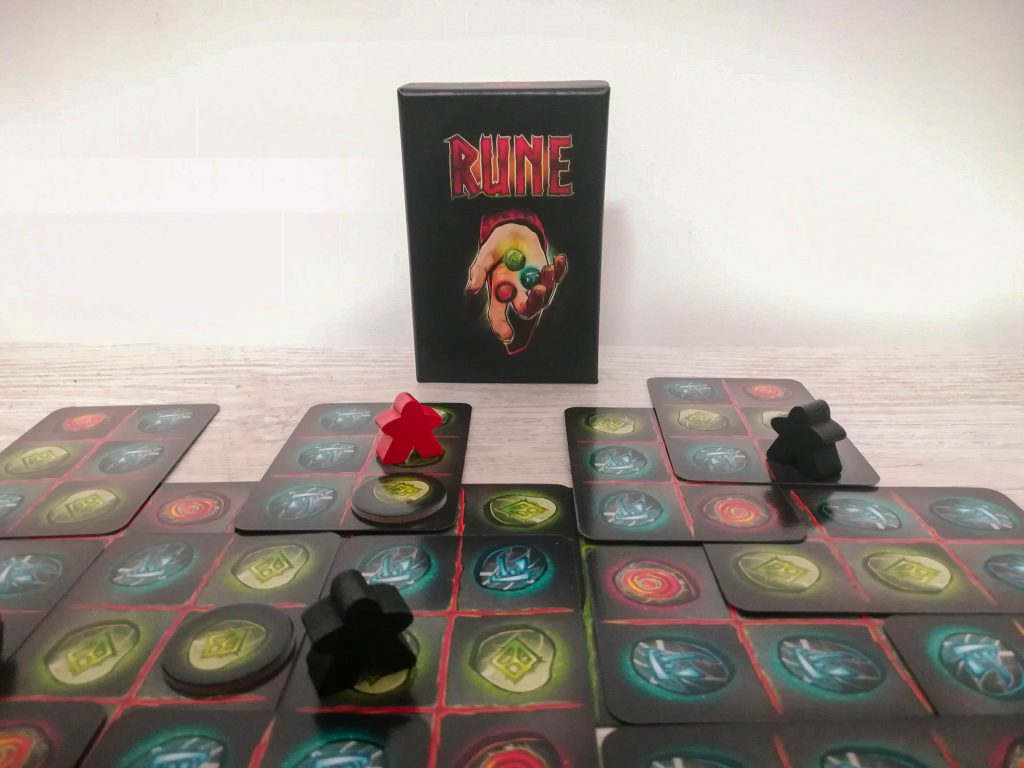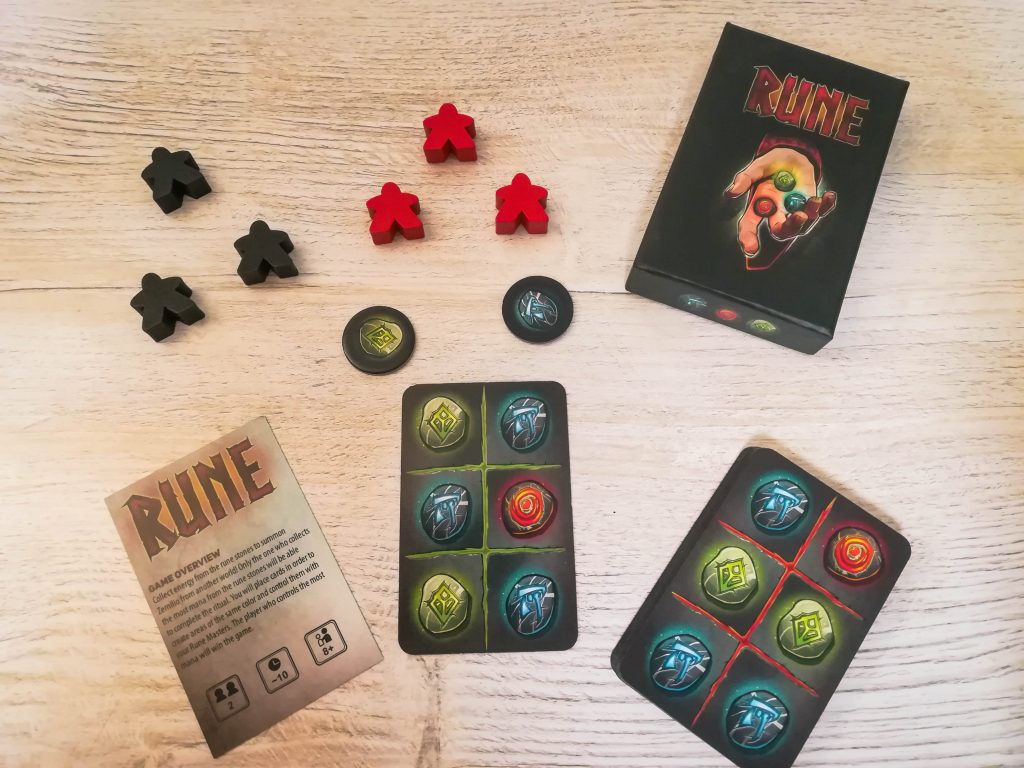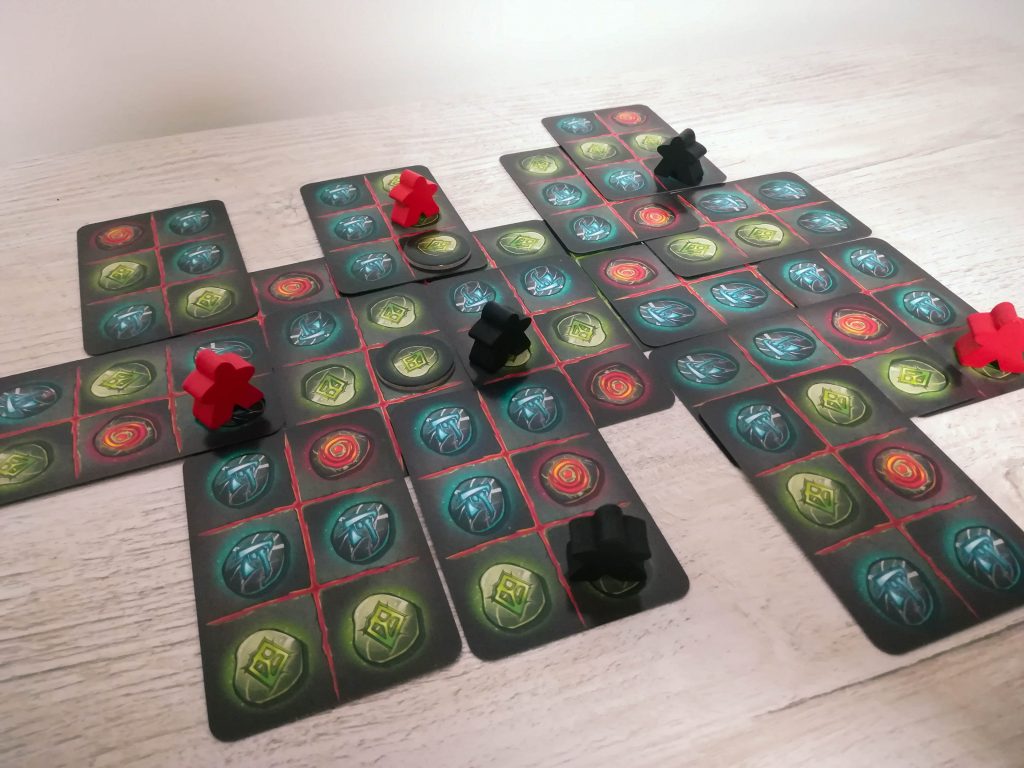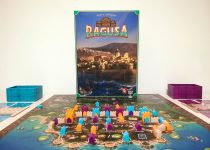Rune – Journal Entry #16

Rune is a fast-paced card game in which you attempt to summon Zemilio from a distant universe. Only the one who can obtain the most mana from the rune stones can finish the ritual!
I have a funny story related to this game. About a year ago, I participated in a giveaway on Instagram and I won a copy of Rune. I can’t say how happy I was when I saw the result, as this was the first giveaway I ever won. A couple months passed and I still didn’t receive my prize because the customs office lost it TWICE, somehow. So I gave up on my hopes to ever get my game.
Fast forward a few months later, I saw that the game will be going through a Kickstarter campaign this Autumn. I contacted the designer to tell him my funny story about his game. Zemilio then offered to send me the prize himself because he doesn’t like such situations when a person is wronged, especially if it’s related to one of his designs. That was such a kind thing to do and I want to thank him for doing this! Here I am now, writing a review on this game, a year later than expected.
How to play
The box contains a deck of 17 cards (1 Starting Card and 16 Rune Cards), six meeples and two tokens, along with the rule sheet. The Starting Card and the Rune Cards are divided into six sections. Each section contains a Rune in one of the three colors: red, green or blue.
The setup is simple and fast. Place the Starting Card (double-sided) near the center of the play area, shuffle the remaining cards and deal 3 of them to each player. Each player chooses his color and picks his corresponding Rune Masters, and then the game can begin.

The game plays over a series of turns alternating between the players until both players have placed their last Rune Master. On their turn, a player has to place a card from hand and then either draw a card from the deck or place a Rune Master.
When placing a card, the player has to lay it over one or more cards on the table, covering at least one Rune of the card(s) below it and follow at least one of the rules below:
- Each Rune must match the color of the Rune beneath it
- Each Rune must match the color of all adjacent Runes on different cards
The player may not completely cover all six Runes on another card. You can not place a card on top of a Rune Master or connect areas of the same color controlled by the opponent’s Rune Masters.
The player can only draw a card if there are any available in the draw deck. Otherwise, he must place a Rune Master. You can not place your Rune Master on top of a Rune that is under the control of another Rune Master. After placing it, you gain control of all the runes of the same color connected either vertically or horizontally.
After both players have placed their last Rune Master, the game ends. Each player gains points for the Runes controlled by his Rune Masters and the player with most points wins.
The two double-sided tokens represent the Grand Master micro-expansion. If you choose to play with it, deal one token to each player at the beginning of the game. This expansion adds a new rule to the game: after placing a Rune Master, the player can place this token on top of a Rune adjacent (even diagonally) to the Rune Master to change the Rune color.
My thoughts about Rune
The first thing that got me interested when I saw Rune a year ago was the artwork. The game is illustrated by Tristam Rossin, the same person that illustrated Cosmic Colonies. The hand holding the Runes that’s drawn on the front of the box is neat, a very good representation of what’s to find inside the box. The Runes on the cards look really nice. The colors are vibrant and the lines that separate the Runes are very easy to distinguish. All in all, the artwork fits the theme well while also looking great.
The game is so small and there are not many component inside the box, but I think that’s the charm of it. The box itself is just a tad bigger than the cards and the components fit perfectly inside it. You may think that for such a small amount of components, the game may lack something. After playing it a few times, I came to the conclusion that Rune is a good example of a game that keeps it simple yet manages to give you a great, fun experience when playing it.

I like how easy it is to learn this game. The rules are easy to understand, intuitive and also easy to teach to new players. It will take you less than 2 minutes to understand the game and then you can start playing. A match usually takes less than 10 minutes and I think that’s just perfect for what it offers.
There’s very little luck involved in the game and I really enjoy that. Since all cards respect the same pattern of six runes (3 blue, 2 green and 1 red) arranged in a different layout, the only luck factor is what card will you draw on your turn. However, when choosing what card to place down, you’ll always have a few cards available in your hand. This diminishes the luck factor by having multiple choices available instead of being forced to place down the card that you’ve just drawn.
That’s all I’ve had to say about Rune. It’s a light card game that packs enough strategy for a game that plays in less than 10 minutes usually. Recommended for those that look for a quick filler game, as you will certainly enjoy it if you’re a fan of tile placement, area control games, especially because of the overlapping mechanic, which allows for smarter tile placement.
Useful info
Designer: Zemilio
Publisher: Little Rocket Games
Players: 2
Time: 10 min
Times played: 7
Full disclosure: A copy of Rune was provided by the game designer.
Did you like the review? Follow me on my Instagram page where I post daily photos of games I play and other things. You can also support me on Patreon to gain access to various special content, such as game unboxings, first impressions, polls to decide what games to cover next, and early access to reviews!


